ConvertPro is an excellent lead-generation plugin for WordPress. It’s designed primarily for building your email list, but I’ve successfully repurposed it for promoting affiliate offers instead (quite effectively I might add).
It’s a tool that I know well and have used personally on multiple niche sites, including two that combine for six-figures annually. So yeah, it’s good.
In this ConvertPro review, I’ll cover its features, capabilities, limitations, pricing and more. I’ll also discuss how it compares to other products in the space, such as OptinMonster, Popupmaker & Thrive Leads.
ConvertPro: Quick Look
Here’s a quick overview of the product, its most important features, and unique capabilities. This should give you an idea whether ConvertPro has the features you’re looking for.
Features
- Drag and Drop – Design visually with drag ‘n drop simplicity.
- Multiple CTA Formats – Popups, sticky navbars, slide-ins and more.
- A/B Testing – Test your CTA copy, style, targeting and more. Continuously optimize and refine your funnel for maximum conversions.
- Pre-built Templates – No more designing from a blank page (unless you want to). Just modify the professional designed templates.
- Advanced Targeting – Target users by country, referral source, device type and more.
- Triggers – Trigger the CTA on conditions you specify, including exit-intent, time-delay or button-click.
- Multi-step forms: Reduce friction, collect more information, or even use conditional logic for better segmentation.
- Conversion Tracking – Track your form conversions and conversion rate in Google Analytics. It can also be modified to track affiliate clicks (custom functionality).
- Integrations: ConvertPro integrates with all the most popular CRMs and Email Marketing software.
The company behind ConvertPro
ConvertPro is built by Brainstorm Force, a powerhouse WordPress development studio responsible for the insanely popular Astra Theme, and several other plugins such as Schema Pro. The result is a functional, beautifully designed plugin with minimal bugs and frequent updates.
ConvertPro Pricing
ConvertPro’s pricing model is a breath of fresh air compared to their competitors (many of which have pageview and website limits).
| ConvertPro | Opt-in Monster | |||
|---|---|---|---|---|
| Plan | Standard | Plus | Pro | Growth |
| Domains allowed | Unlimited | 2 | 3 | 5 |
| Pageviews/month | Unlimited | 10,000 | 25,000 | 100,000 |
| Price (annual) | $79 | $228 | $348 | $588 |
In contrast, ConvertPro’s pricing is an unlimited license. You can use it on as many websites as you want with unlimited pageviews and conversions.
How much does ConvertPro Cost? ConvertPro is priced at $79/year which includes all features and unlimited websites.
Oh, and there’s a lifetime option too. You can get a lifetime ConvertPro license for $399 (which is a mediocre value in my opinion).
But the better option is to go for the Brainstorm Force Lifetime Bundle, which includes all their current and future plugins, plus the Astra Pro theme for $699.
The Dashboard
The dashboard is where you can monitor the recent performance of all your CTA campaigns, as well as enable/disable running campaigns.
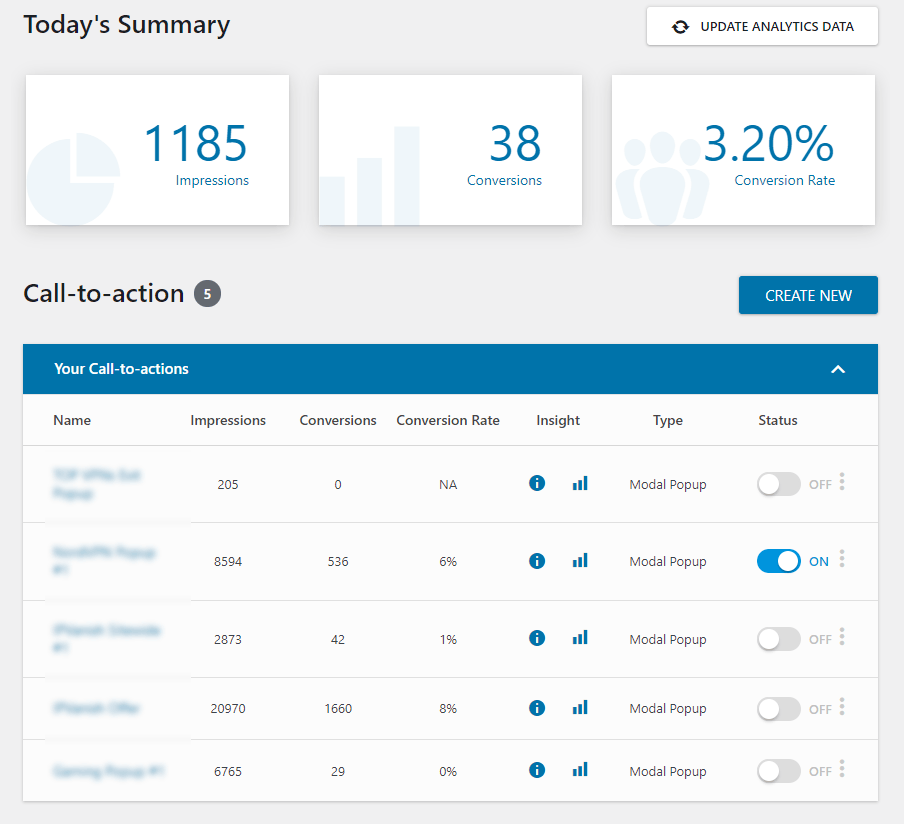
From here you can also create a new CTA, run and A/B test, or access the plugin settings.
Creating a Call-to-Action (CTA)
The conversion elements you design in ConvertPro are called CTA’s (short for Call-To-Action). It’s marketing-speak for a fancy element designed to make a user take action (enter their email, click, buy something, etc…)
Call To Action Types:
ConvertPro has 8 different CTA types, and get all be used in different locations on your site (if you like) or a/b tested to find the best CTA type for your audience.
You can choose from these types:
- Popup: a light-box overlay centered on the screen
- Info Bar: a screen-width bar at the top or bottom of the screen (like Hellobar)
- Slide-in: A panel that slides in from the side of the screen
- Before/After: CTA box inserted before or after your page content
- In-Content: CTA box inserted anywhere in your content (via shortcode)
- Widget: for your sidebar or widget areas
- Convert Mat: Full-screen entrance CTA
- Full-screen Popup: Like the Convert Mat, but triggered later in the pageview
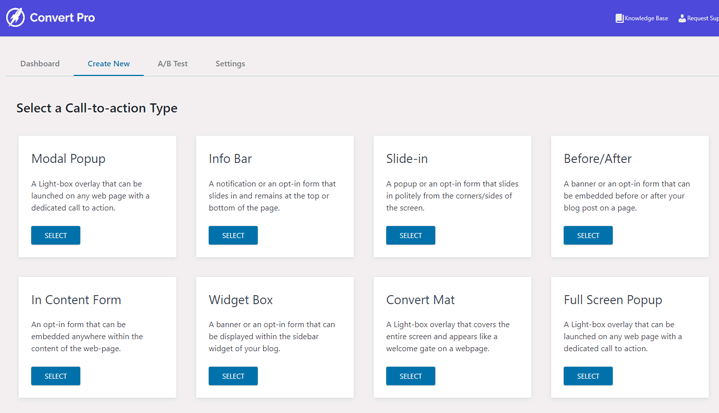
Pre-built Templates
After choosing a CTA type, you can choose from the available starter templates for that type. This can save you a ton of time because all the elements are already in place, just replace the images, adjust the colors, text and links and you’re good to go.
You can also start with a blank template if you prefer designing from scratch or can’t find a template that fits your use-case.
You can also filter the available templates by conversion goals (like collect emails, limited-time offer), or functionality (exit intent, content lock).
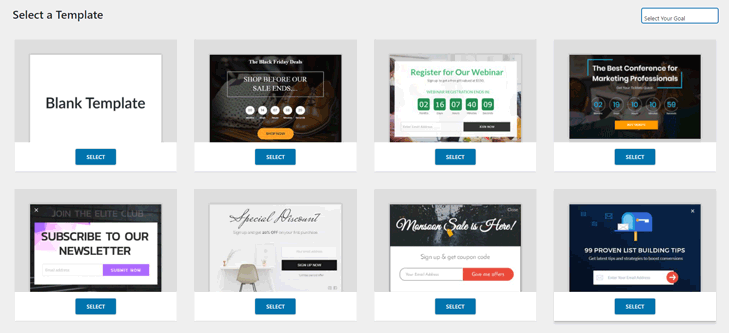
Using The Visual Editor
ConvertPro’s visual editor is well-designed and the UI is very intuitive. You place and style elements directly on the CTA canvas. It’s rendered in real-time so it should look exactly the same on the front-end when it goes live.
Available Elements
There are 5 different categories of elements or blocks you can edit on your CTA.
- Basic Elements – Text, headings, images, videos, HTML Code, countdown timers
- Form Elements – Form fields and styling controls for your forms
- Buttons – Action elements that submit a form, download a file, or link to a URL.
- Shapes – SVG shapes and icons help your design stand out
- Panel – The look and behavior of the CTA element itself (i.e. the popup window)
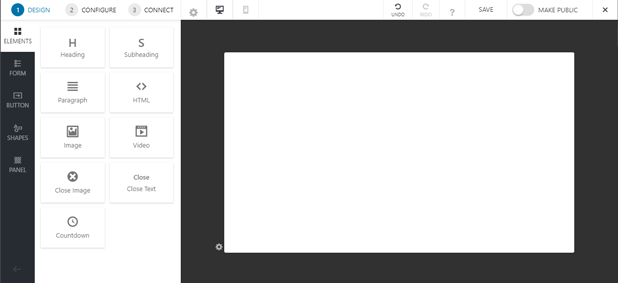
Adding Elements to the Canvas
The Convertpro designer gives you full control over the placement of elements. You can drag them literally anywhere within the canvas (or even off the canvas if you want). They are anchored to the exact x,y coordinates, rather than be forced into a specific grid or block layout like you are with Gutenberg.
Once you get the hang of it, it’s quite freeing. The designing process is much closer to a tool like Canva, instead of the typical block-based builder.
To add an element – Simply drag it into the canvas. You can drop it, reposition, resize and style it without restriction.
Shortcuts and Workflow
The builder uses some common keyboard shortcuts to speed up your design process. I especially appreciate Ctrl + Z (undo) and Ctrl + Y (redo).
There’s also a handy ‘duplicate element’ button for repeated elements.
Here’s the workflow I typically follow when using ConvertPro:
- Adjust the panel dimensions
- Add a Panel Background (color, gradient or image)
- Add a clear heading and optional subhead
- Add the opt-in form and/or button
- Set the form
Building a CTA from scratch
You can prototype or fully design your callouts from scratch quite fast. You could complete the design of a simple popup under 5 minutes.
Example Design:
- Set a background image for the popup panel
- Add a heading
- Add email field and submit button
- Add a ‘close’ button (top right)
- Adjust the colors and typography
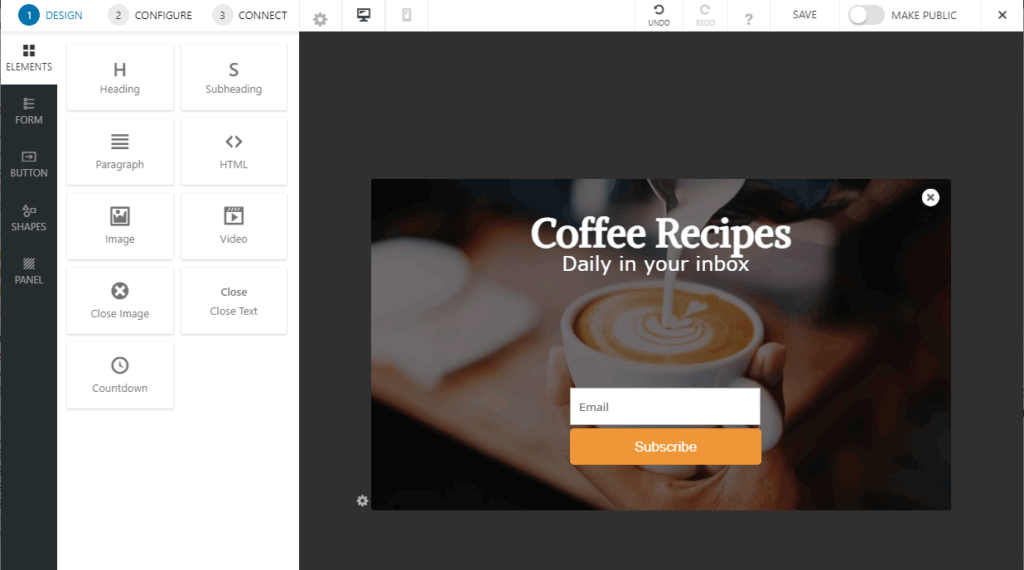
Configuration options (triggers)
Designing your CTA is just the beginning. The real power of ConvertPro rests in the targeting and complex triggering options.
CTA Launch Triggers
Many CTAs such as slide-ins or modals (popups) will be hidden during the initial page load. They’ll then pop, slide, or wiggle into view only after some trigger event that you set.
And there are dozens of trigger events to choose from, including:
- Exit Intent (cursor moves to out of window)
- Time delay
- Link Click
- Scroll depth
- Scroll to a specific element (CSS selector)
- User inactivity
- Specific referrer
- Custom cookie
- and more…
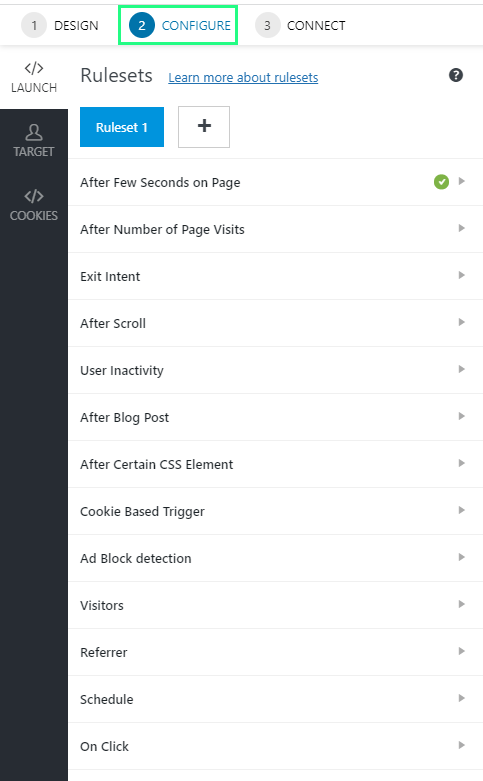
And these triggers can be combined in an and/or fashion by using multiple Rulesets, allowing you to specify multiple conditions where the CTA will load.
Targeting Options
After specifying the ‘launch’ event that will trigger your CTA, next you need to set targeting conditions which determines where on your site the CTA will load.
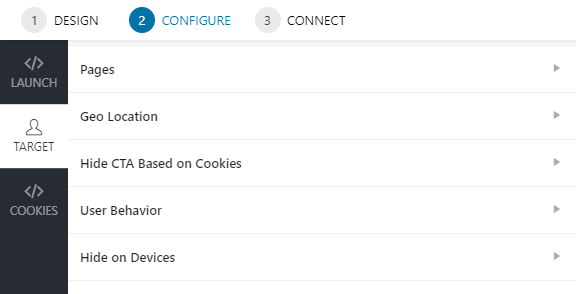
These targeting conditions are combined in an and fashion, meaning the CTA will only display in when all of the conditions are true.
The conditions are well though out and useful. They include:
- Pages: Choose specific categories, tags, post types, taxonomies, or even individual posts
- Geo-Location: Specific countries or EU/non-EU
- Custom Cookie: Hide the CTA if a cookie is set (for example, an existing subscriber, someone who has purchased a product already, etc)
- User Behavior: Whether the user is logged-in (or not)
- Hide On Devices: Select whether or not to display the CTA on Mobile, Tablet and Desktop screens.
Cookie Settings
Don’t want to annoy visitors with the same popup on every pageview? (it’s so annoying)
ConvertPro has you covered. You can easily create a custom cookie to hide the popup for a specific number of days after the visitor converts, or closes the CTA. You can specify a different duration for each.
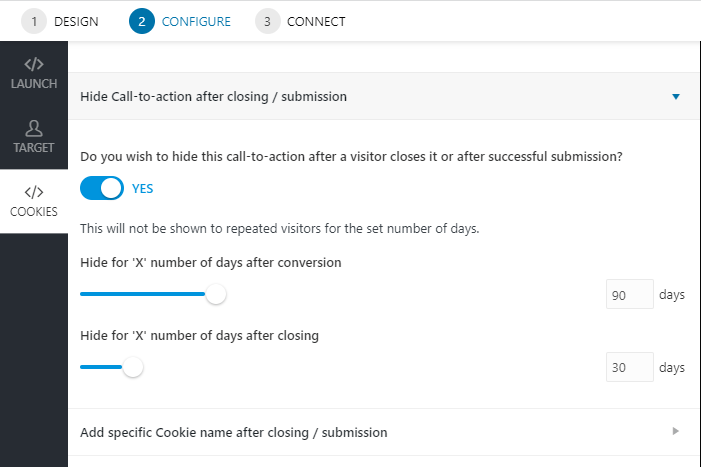
You can also set custom cookies if you like (requires a bit of Javascript ability to use effectively).
Going Live
The entire design and configuration process takes place behind the scenes, on a private post type. When you’re happy with your CTA, however, going live is simple.
- Go live from the design screen: Flip the switch labelled make it public
- Go Live from the Dashboard: Turn the CTA switch to On
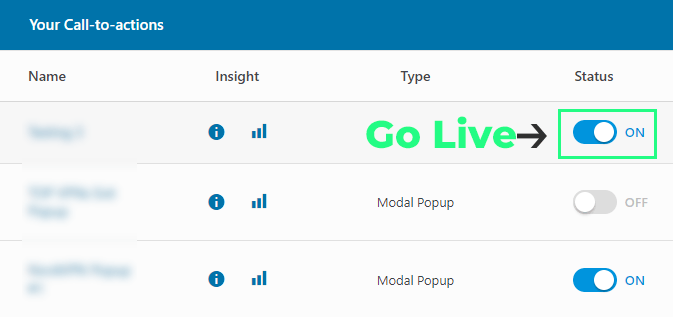
All that’s left is to visit the front-end of your site (preferably in an incognito window) and test the CTA to make sure your triggers fire as expected.
ConvertPro Forms
ConvertPro is designed primarily as an lead-gen tool. It’s designed to capture email addresses and build your email list.
It has all the form field types you’d expect, and integrates with dozens of API’s and Email Service Providers.
ConvertPro Form Fields:
- Checkbox
- Date
- Dropdown
- Hidden
- Name
- Phone
- Radio Button
- ReCaptcha (anti-spam)
- Text
Multi-step Forms
One of my favorite features is the ability to create Multi-Step forms. These are quite popular with successful marketers for the simple reason that they work.
Multi-step forms let you ease a prospect into a funnel by making micro-commitments.
For example, the initial CTA view might simply display a yes/no question with no visible form fields. Then the second (or third) step might contain the email-optin form with an irresistible offer.
And the multi-step feature is quite flexible. You can use it to create mini-quizzes or to segment your list on the fly. Both of these are really powerful techniques once you learn how to leverage them.
Form Integrations
Connecting my form to my ESP (I use ConvertKit here at BTW) was super simple.
First, you need to enable the ConvertPro Connects addon, which you can find under Settings > Addons.
This will add a new section to the ‘connect’ tab of the CTA builder, where you can add the API key for your ESP, and map the form fields to your provider’s form.
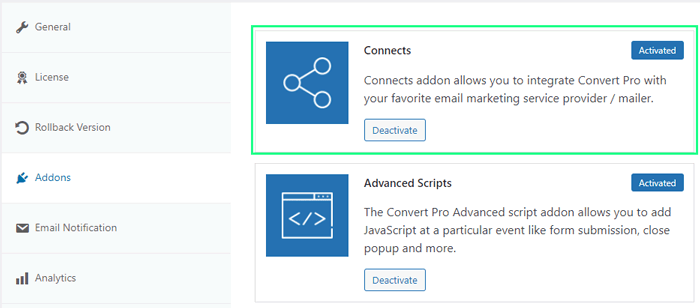
Then, while designing a CTA you can go to the Connect tab, choose your ESP provider, and add your API key.
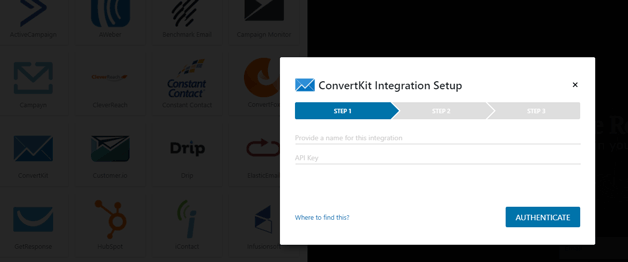
After that, you simply map the fields from your ConvertPro CTA to the form fields already in your Email Provider’s back-end. The API handles the rest and will transfer the form data just as if your visitor was filling out the your Email Service Provider’s own form, including tags and segmentation data.
Analytics & Conversion Tracking
Unlike other opt-in plugins I’ve used, ConvertPro tracks conversions by integrating with Google Analytics, firing a custom event for every impression and conversion.
Most of their competitors track conversions on-site using PHP and/or Javascript and store the conversion data locally.
Viewing Analytics Data
You can get a limited snapshot of your Conversion data from your ConvertPro dashboard, but you can get a detailed breakdown in your Google Analytics dashboard.
What’s great about this approach is you can use the full power of GA to analyze your conversions by custom segments, or break-out the data by device, landing page, traffic source, and more.
Here’s some conversion data for on of my affiliate popup offers I ran using ConvertPro:
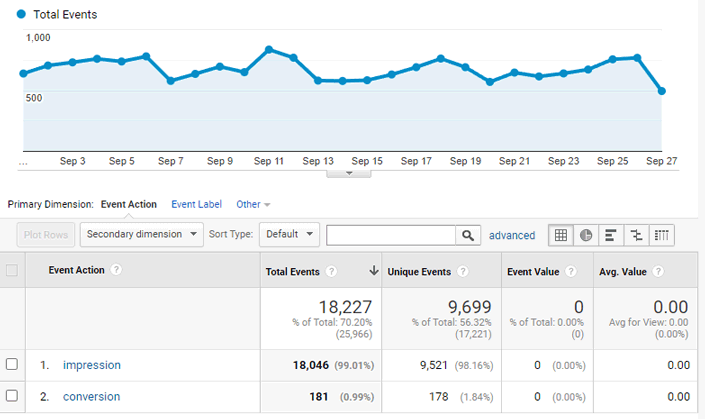
While my 1% conversion rate might not seem impressive, this was for an exit-intent popup which is generating between $250 and $400 of extra revenue every single month. And it’s from people who were about to click off the site before I grabbed their attention.
Drawbacks (analytics)
ConvertPro’s approach does have a few downsides to be aware of:
- You have to give the plugin access to your Google Analytics account
- You have to use Google Analytics
- You have to refresh the analytics data to pull in from GA to your ConvertPro dashboard.
Advantages (analytics)
There are a number of advantages here too, and in my opinion the pros heavily outweigh the cons.
Biggest Advantage (for me): You can easily create custom event triggers (using Google Tag Manager) to track affiliate conversions. Something that isn’t possible with most competing plugins.
Pros of ConvertPro analytics tracking:
- Harness the full power of Google Analytics
- More detailed information about who’s converting on your forms
- Create your own custom conversion events (e.g. affiliate clicks)
Tracking Affiliate Clicks / Conversions
I’ll probably do a complete tutorial on this eventually, but here’s the short version on how to set it up.
Note: ConvertPro doesn’t natively support this, but it’s easy to configure yourself because the plugin uses native Google Analytics events to track conversions rather than tracking them locally.
Steps:
Create a CTA – Create a popup or CTA that has at least one affiliate link
Add CSS Classname – Add CSS class to your affiliate link, which we will use to trigger the conversion event. This can be added in the ‘custom’ section of the button element in the ConvertPro builder. You can also use a custom html element to add it manually.
Create the Conversion Event – The impression event fires when the CTA loads in the viewport, but with no form to submit, ConvertPro can’t create a conversion event. So we’ll create our own.
Using Google Tag Manager or a Plugin like Gravitate Event Tracking, create a custom event that fires when I link is clicked. We’ll use the css class you created above as the trigger.
You also need to pass some data to the event:
- Event Action – Convert Pro
- Event Label – conversion
By simply matching the exact data structure that ConvertPro uses for form conversions, you can basically ‘spoof’ a conversion. The plugin will then pull this data into the dashboard which can be used for A/B testing.
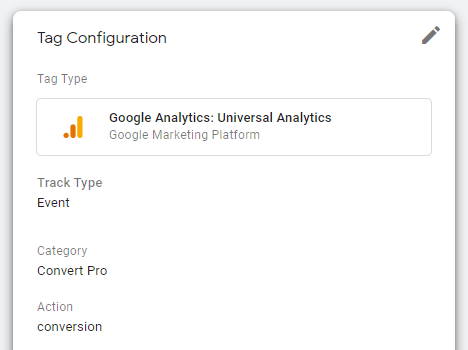
ConvertPro A/B Testing
ConvertPro lets you create an unlimited number of A/B tests. This lets you pit two different CTAs against each other, to see which has a higher conversion rate. You can continually improve your conversion rate with a cycle of Test > Tweak > Test > Tweak.
The testing functionality is pretty basic. You choose two of your existing CTAs to test, choose a start/end date and start the test.
A winner will be declared after the testing window is over. You can choose to automatically start running the Winner when the test ends.
So while it’s good enough to be useful, it doesn’t match the experimentation capabilities of a tool like Optin Monster, Unbounce, or Thrive Leads.
ConvertPro versus the competition
| ConvertPro | Opt-in Monster | Unbounce | |
|---|---|---|---|
| Price (year) | $79 unlimited websites | $348 (3 sites) $588 (5 sites) | $972 (1 domain) $1458 (5 domains) |
| Price (lifetime) | $399 | N/A | N/A |
| Pageview limit? | unlimited | yes | Pageview and Conversion limits |
| CTA Types | Mat, Popup, Floating bar, Slide-in, embedded, widget | Popup, Scroll box, Gamified (wheel), Content Locker, Floating bar, Slide-In | Popup, Floating Bar |
| Page level targeting | Yes | Yes | Yes |
| Track affiliate conversions | Yes | No | No |
| A/B Testing | Yes | Yes | Yes |
| Integrations | 39+ | 49+ | 120+ |
There are a number of high quality tools in this space (both plugins and 3rd-party services like Unbounce).
How does ConvertPro compare to heavy hitters like Optin Monster?
ConvertPro vs. Optin Monster
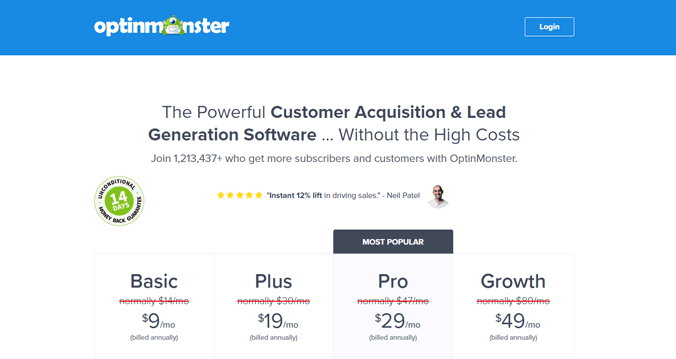
Both ConvertPro and Optin Monster have a pretty similar list of features, and each is geared towards list-building.
Where Opt-in Monster has the edge:
- More CTA types, including content-lock (awesome) and Gamified Popups (kinda gimicky).
- Better A/B Testing
- Advanced form personalization and retargeting
- Support is a bit more responsive
Where ConvertPro has the edge:
- The visual builder is more flexible and easier to build that exact design in your head
- Affiliate conversion tracking (with custom events)
- Substantially cheaper
- Lifetime subscription option
My biggest complaint about opt-in monster (which is still excellent) is the pageview limitation on most plans. ConvertPro has no artificial limits and can be installed on an unlimited number of sites.
As a result, ConvertPro is substantially cheaper than Opt-in monster, especially if you have a high traffic site or multiple domains, which would force you onto OIM’s most expensive plan.
And the core functionality between these two plugins is pretty similar. Aside from the content-lock feature and the gimmicky spinning wheel CTA (which Neil Patel seems to love) there isn’t much difference.
Bottom Line: ConvertPro is a fantastic value compared to Opt-in Monster, with very similar capabilities.
ConvertPro vs. Thrive Leads
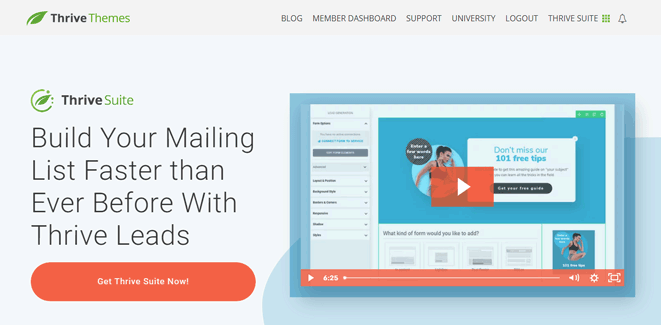
Thrive Leads is part of the ‘Thrive Suite’ which is an all-in-one bundle of plugins that can be combined to build almost any type of site.
The advantage of the suite is that each plugin integrates perfectly with other tools in the suite. For example, you build Popups in Thrive leads using the Thrive Architect page builder, and A/B test them with Thrive Optimize.
But one big downside is the plugins are so deeply integrated that you can’t buy them separately. You have to buy the entire suite if you want any. At $228/yr that’s an excellent value, but it’s nearly 3x the cost of a ConvertPro license.
Where Thrive Leads has the Edge
- Deep integration with other Thrive products
- Get insane conversion rates with Thrive Quizbuilder opt-in gates
- Better A/B testing
Where ConvertPro has the edge
- Cheaper if you don’t need all the other Thrive plugins
- More CTA Types
- Track affiliate conversions (Thrive leads still doesn’t support this)
- Better Builder (I find Thrive Architect a bit finicky for intricate designs)
- Less bloat – Thrive leads requires two other plugins (Thrive dashboard and Architect) to be installed on your site. 3 total plugins.
My Take: I’ve been a Thrive Suite subscriber for years now and do use it on some sites because it’s a great value for an all-purpose toolkit. That said — ConvertPro is my choice when I just want a Conversion plugin, and don’t need the whole shebang.
ConvertPro vs. Unbounce
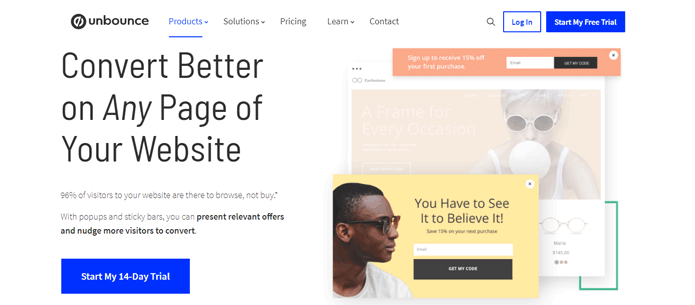
Unbounce is an excellent 3rd-party conversion tool that works with any website. Instead of using a native WordPress plugin, you integrate Unbounce via a bit of Javascript code that you add to your site (there is an Unbounce plugin for Landing Pages).
Unbounce is geared towards both lead-gen, but also PPC optimization and landing page design. With recently reconfigured pricing, you can’t just buy the CTA-builder, you have to buy the entire optimization platform, which starts at $81/month and limits you to 500 conversions.
My Take: While I think Unbounce is a great tool, it’s not a compelling value compared to ConvertPro (or the other excellent CTA plugins available). That’s why unbounce is usually used by companies that run on a non-WordPress platform and need a 3rd-party solution.
Verdict: is ConvertPro Worth It?
If you’ve read the whole review to this point, it’ll be pretty clear that ConvertPro is an an exceptional value in a crowded segment. It has 90% of the features of expensive competitors (like Opt-in Monster) at a fraction of the cost.
And not only that, the ability to track affiliate clicks as conversions is a competitive advantage that most other lead-gen plugins don’t offer.
What I like about ConvertPro
What ConvertPro could do better
As you can see, my experience with ConvertPro has been overwhelmingly positive. And most importantly, I’ve never felt it lacked features or felt compelled to switch to another plugin (even though I have other licenses).
Who should use ConvertPro?
ConvertPro will be a good fit for most bloggers or website owners, but here’s some advice on when to choose ConvertPro vs a competitor:
Choose ConvertPro if:
- You have 3 (or more) websites or lots of traffic
- You don’t need a content-locker
- You want to track affiliate conversions
- You want the best value for the money
When to consider alternatives
In my mind, there are only a couple reasons to consider a different tool. The first is if ConvertPro simply doesn’t have a critical feature or integration that you need.
Another reason might be if you want an all-inclusive bundle for building websites, in which case I’d look at Thrive Leads and the Thrive suite.
And finally, if you only need Popups and are like Elementor, you should consider upgrading to Elementor Pro which lets you build custom popups, has decent templates, exit-intent triggers and integrates with most email software.
Final Verdict
ConvertPro has everything you need to build an email list or promote affiliate offers on your website. It’s well-coded, stable, and flexible enough for any website.
And at $79/year, I think it’s an unbeatable value in the segment. If you’re ready, you can buy ConvertPro.
Review Summary
ConvertPro Review

Review of ConvertPro, the WordPress opt-in plugin from Brainstorm Force
Price: 99
Price Currency: USD
Operating System: WordPress
Application Category: WordPress Plugins
8.5
